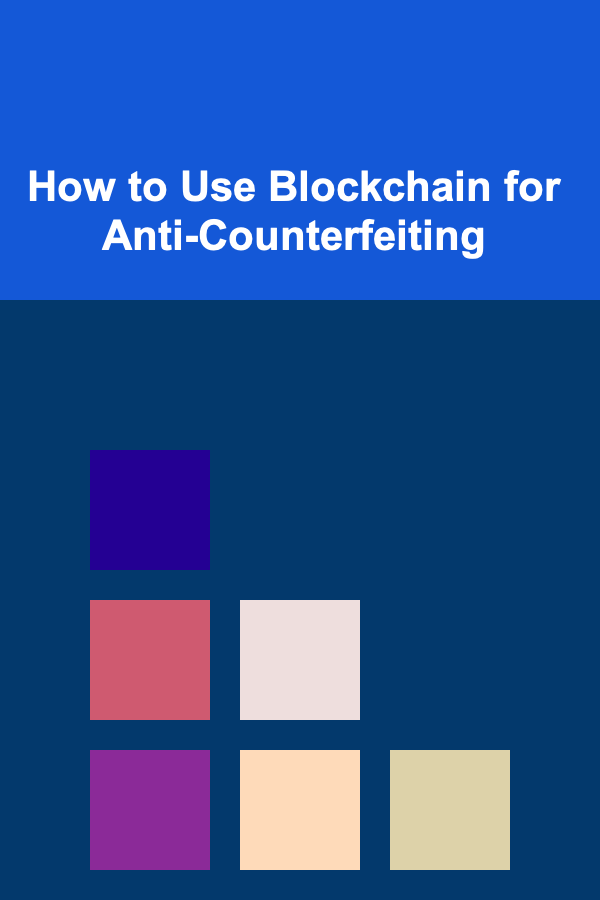
How to Use Blockchain for Anti-Counterfeiting
ebook include PDF & Audio bundle (Micro Guide)
$12.99$9.99
Limited Time Offer! Order within the next:

The issue of counterfeiting has plagued various industries for decades, from luxury goods and pharmaceuticals to electronics and food products. The rise of global trade and the expansion of e-commerce platforms have only exacerbated the problem. Counterfeit goods are not only a financial burden on legitimate businesses, but they also pose significant risks to consumer safety and brand reputation.
One of the most promising solutions to combat this widespread problem is blockchain technology. Originally developed as the underlying framework for cryptocurrencies like Bitcoin, blockchain has since found applications in a wide range of industries, including supply chain management, finance, and healthcare. Its ability to provide transparent, immutable, and tamper-proof records makes it a powerful tool for anti-counterfeiting measures.
This article explores how blockchain can be leveraged for anti-counterfeiting, examining its key features, applications, and potential challenges.
What is Blockchain?
Blockchain is a decentralized, distributed ledger technology that records transactions across multiple computers in such a way that the registered transactions cannot be altered retroactively. Each "block" in the chain contains a list of transactions, and once a block is added to the blockchain, it is considered permanent and immutable. This ensures data integrity and eliminates the need for intermediaries, which has significant implications for industries where trust, transparency, and security are paramount.
Some of the defining characteristics of blockchain include:
- Decentralization: No central authority controls the blockchain. Each participant (node) in the network has an equal say in the validation of transactions.
- Immutability: Once data is recorded in the blockchain, it cannot be altered or erased. This makes it ideal for maintaining permanent records.
- Transparency: Blockchain provides a transparent and auditable system, allowing participants to verify the history and authenticity of transactions.
- Security: Blockchain uses advanced cryptographic techniques to secure data and prevent unauthorized access or manipulation.
These characteristics make blockchain an ideal solution for tackling the problem of counterfeiting, which often arises due to a lack of trust, transparency, and verifiability in traditional supply chains.
How Blockchain Solves Anti-Counterfeiting Issues
Blockchain can play a pivotal role in the fight against counterfeiting by providing a secure and transparent means of tracking products throughout their lifecycle. Below are some of the key ways blockchain addresses the challenges of counterfeiting:
1. Product Authentication
The fundamental issue with counterfeiting is the inability to authenticate products reliably. Counterfeit goods often mimic the appearance and packaging of legitimate products, making it difficult for consumers to distinguish between the two. Blockchain can address this issue by providing an immutable record of the product's origin, manufacturing process, and distribution path.
Through blockchain, each product can be assigned a unique identifier (such as a serial number or QR code), which is recorded in a blockchain ledger. This identifier can then be used to track the product's journey from the manufacturer to the end consumer, ensuring its authenticity at every step.
For example, in the luxury goods industry, a high-end watch could be assigned a unique blockchain ID that links to a secure, immutable record containing details about the watch's design, materials, and manufacturing process. When a consumer purchases the watch, they can use a mobile app to scan the QR code or enter the ID to verify its authenticity against the blockchain.
2. Supply Chain Transparency
One of the major challenges in combating counterfeiting is the lack of transparency in supply chains. Counterfeit goods often enter the market through gaps in the supply chain, where manufacturers, distributors, or retailers may not have adequate oversight of the products' provenance. Blockchain can provide an end-to-end solution for supply chain transparency, enabling all stakeholders to access a shared, immutable record of the product's journey.
By using blockchain to track products at every stage of the supply chain, from raw materials to final delivery, businesses can identify and eliminate weak points where counterfeiting may occur. Each time a product changes hands, a new transaction is recorded in the blockchain, providing a complete, auditable history of the product's movements.
For example, in the pharmaceutical industry, counterfeit drugs are a major concern. Blockchain can help ensure that each batch of medication is tracked from the manufacturer to the pharmacy, preventing the introduction of fake drugs into the market. With blockchain, consumers and regulators can verify that the medication they are purchasing is genuine and has not been tampered with.
3. Ownership and Provenance Tracking
Counterfeit products often lack a clear chain of ownership, making it difficult to trace their origins and ensure their authenticity. Blockchain solves this problem by creating a digital "passport" for each product, which records its ownership history from the moment it is produced until it reaches the consumer.
This is particularly important in industries like art, antiques, and luxury goods, where provenance plays a critical role in determining the value of an item. By using blockchain to record every transfer of ownership, stakeholders can easily verify the authenticity of high-value goods and prevent the circulation of fake or stolen items.
For instance, in the art world, a piece of artwork could be registered on a blockchain with details about its creation, previous owners, and exhibitions. This blockchain record provides a transparent, immutable history of the artwork's provenance, which can be used by buyers, sellers, and auction houses to authenticate the work and determine its value.
4. Smart Contracts for Automated Compliance
Smart contracts are self-executing contracts with the terms of the agreement directly written into code. These contracts automatically execute when predefined conditions are met, without the need for intermediaries. Smart contracts can be used to automate various aspects of the anti-counterfeiting process, ensuring that all parties in the supply chain adhere to the agreed-upon terms and conditions.
For example, a smart contract could be programmed to automatically release payment to a manufacturer only when the product has been verified as genuine and its journey through the supply chain has been recorded on the blockchain. Similarly, retailers could be required to provide proof of purchase from an authorized distributor before selling a product.
This automation reduces the risk of human error or fraudulent activities and ensures that all stakeholders in the supply chain remain accountable.
5. Consumer Empowerment
Blockchain can empower consumers to verify the authenticity of products before making a purchase, reducing the likelihood of buying counterfeit goods. By using a mobile app or a website, consumers can easily scan a product's QR code or enter its unique blockchain ID to access a transparent record of the product's history.
This increases consumer confidence and trust in the products they buy, making it less likely that counterfeit goods will be purchased. For example, in the food industry, consumers can verify the origin of their food products by scanning a code that links to the product's blockchain record, ensuring that it has been sourced sustainably and is free from contaminants.
6. Brand Protection
For businesses, counterfeiting represents a serious threat to brand reputation. A single counterfeit product can damage consumer trust and erode the brand's image. Blockchain helps protect brands by providing a transparent and verifiable system for ensuring product authenticity.
By using blockchain to track and authenticate products, companies can demonstrate their commitment to quality and transparency. This not only helps to prevent counterfeit goods from reaching consumers but also strengthens the company's brand by showing that it is taking proactive steps to protect its products.
Real-World Examples of Blockchain in Anti-Counterfeiting
Several industries have already begun to experiment with blockchain technology for anti-counterfeiting purposes. Below are some real-world examples of how blockchain is being used to combat counterfeiting:
1. Luxury Goods
The luxury goods industry has long been plagued by counterfeiting, with fake handbags, watches, and jewelry flooding the market. Companies like Louis Vuitton and LVMH are exploring blockchain to authenticate their products and ensure that only genuine items are sold to consumers. By integrating blockchain technology into their supply chains, these brands can track each item's journey from production to point of sale, providing consumers with a way to verify the authenticity of their purchases.
2. Pharmaceuticals
Counterfeit drugs are a major global problem, particularly in developing countries, where fake medications can cause severe health risks. Companies like Everledger and Modum are using blockchain to track the movement of pharmaceutical products through the supply chain, ensuring that consumers receive genuine medications. In addition, blockchain can help prevent the theft or diversion of drugs, improving overall drug safety.
3. Food Industry
Blockchain is being used in the food industry to track the origin and quality of food products, ensuring that consumers have access to authentic and safe food. For example, companies like IBM and Walmart have partnered to use blockchain to trace the journey of food products, from farm to table, making it easier to verify the authenticity and safety of products like organic vegetables, seafood, and meat.
4. Art and Collectibles
The art market has always been vulnerable to fraud, with counterfeit artworks or misrepresented provenance leading to significant financial losses. Blockchain is being used to create digital certificates of authenticity for artworks, ensuring that buyers can verify the origin and ownership history of pieces before purchasing. This helps prevent the sale of fake or stolen art.
Challenges and Considerations
While blockchain holds great promise for anti-counterfeiting, several challenges must be addressed for its widespread adoption:
- Adoption and Integration: For blockchain to be effective in anti-counterfeiting, it must be adopted by all stakeholders in the supply chain, including manufacturers, distributors, retailers, and consumers. This requires significant investment in technology and infrastructure.
- Data Privacy: Blockchain's transparency features can sometimes conflict with the need for data privacy. In some cases, companies may not want to disclose sensitive information about their products, such as their manufacturing processes or distribution networks.
- Scalability: As blockchain networks grow, scalability can become an issue. The larger the network, the more computational power is required to validate transactions, which can result in delays and higher costs.
- Regulation: The use of blockchain in anti-counterfeiting will require regulatory frameworks to ensure that the technology is being used ethically and legally. Governments and industry regulators will need to work together to establish standards for blockchain-based anti-counterfeiting systems.
Conclusion
Blockchain has the potential to revolutionize the way industries combat counterfeiting by providing a secure, transparent, and immutable record of products' origins, movements, and ownership. By enabling better authentication, supply chain transparency, and consumer empowerment, blockchain can help prevent the circulation of counterfeit goods and protect brands and consumers alike.
However, challenges such as adoption, data privacy concerns, scalability, and regulation must be addressed before blockchain can become the standard solution for anti-counterfeiting across industries. As technology continues to evolve and more companies embrace blockchain, we can expect its role in combating counterfeiting to grow significantly in the years to come.

How to Open a Small Bed and Breakfast
Read More
How to Plan a Cozy Winter Party with Friends
Read More
How to Reduce Debt While Building Wealth
Read More
How to Select the Best Organizers for Your Office Drawers
Read More
How to Start Investing in the Stock Market as a Beginner
Read More
How to Identify Edible Plants While Hiking
Read MoreOther Products

How to Open a Small Bed and Breakfast
Read More
How to Plan a Cozy Winter Party with Friends
Read More
How to Reduce Debt While Building Wealth
Read More
How to Select the Best Organizers for Your Office Drawers
Read More
How to Start Investing in the Stock Market as a Beginner
Read More